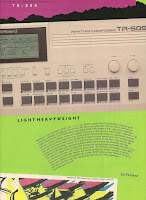Yamaha SY-22 "Vector Synthesis" advertisement from page 39 in the September 1990 issue of Keyboard Magazine.
In a crowded world of 90s synths, the SY-22 vector synthesizer dared to be different. With FM, sample playback and joy-stick driven sound design, its still loved by a small group of fanatics. I've never owned one... and I still consider myself one of those fanatics.
According to the InterWebz, after Sequential Circuits, responsible for the Prophet VS (Vector Synthesis) was bought by Yamaha, Dave Smith "served as the President of the DSD group at Yamaha, producing a mini VS in the Yamaha SY22, but when ownership of Sequential was passed to their newly-acquired Korg, Dave oversaw that as the Korg R&D group in California, who designed the very successful Wavestation."
Interesting. Explains why the Wavestation and SY-22 both came out so soon after each other.
Looking at the SY-22 itself... first, lets get this out of the way. No low-pass filter. Ugh. Okay, we can move on, because what it does have is AWM synthesis, 2-operator FM synthesis, and vector synthesis via a joystick. And now lets throw in stereo onboard effects, as well as velocity keys with aftertouch. SAAAAAAY-WHAAAAAAT?
All for under $1100.
So its not an SY-77. Too bad... The SY-22 has vector synthesis.
So its not an SY-55. Too bad... The SY-22 has vector synthesis.
I think you can see where I'm going with this. Its got vector synthesis. Like I said above - I've never owned one. I don't think I've even heard one on purpose. But in my head, its just got to be cool sounding.
And Jim Aikin, managing editor and Keyboard reviewer back in 1990 agrees. Kinda.
See... he was going on vacation the day the Korg Wavestation arrived for review. So he didn't get to review it. And instead, he came back from vacation with the Yamaha SY-22 waiting for review. so he switched it on and was 'pleasantly surprised'.
Why do I know this?!?! Because the same issue of Keyboard that includes this advertisement, also includes Jim's full-length review of the SY-22.
According to the review, each patch on the SY-22 "can be programmed with its own vector. Once you've found a set of waveforms that you like, you can go to the "record level vector" page and use the joystick to do a real-time recording of a sequence of up to 50 vector positions." FIFTY positions. Then you can edit each position, loop the entire thing, etc. Smashing!
One thing he does note that is a real downer is that the joystick doesn't send or receive midi data. Yup. You heard that right... there's no way to record the movements into your favourite sequencer. Jim acknowledges that Yamaha needed to keep the cost down somehow.
Jim goes on to review the sounds ("usual mixed bag"), patch programming ("fairly predictable"), effects ("short, but no big around"), and multitimbral operation ("fairly standard"). Still, in the end, Jim explains that vector synthesis "gives the SY22 a sound that's unique in its price range", and even calls the real time recording of vector movements "the most significant innovation in synthesizer design that we've seen in the last couple of years".
Nice. Jim done good.
The Yamaha SY-22 may not have achieved mass-market fame, but its combo of vector synthesis, FM synthesis, and sample-based warmth makes it a hidden treasure for all you creative musicians.







